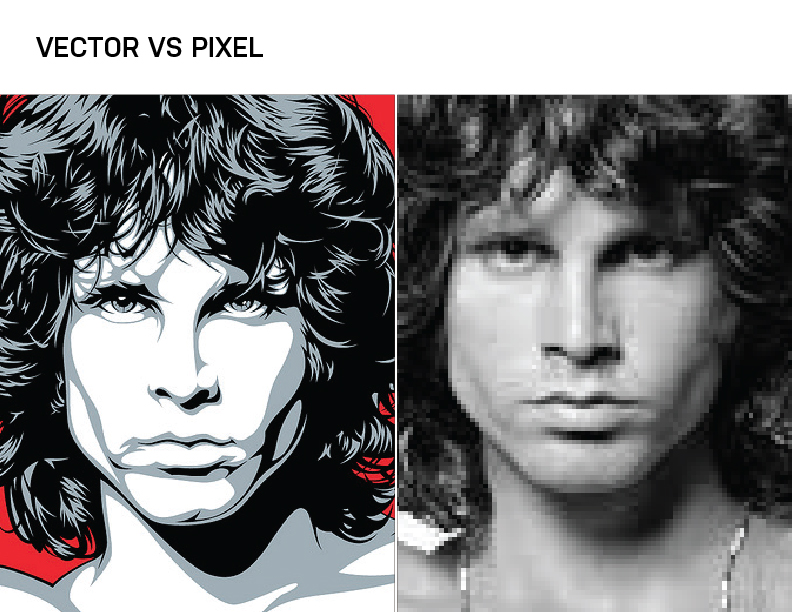
They essentially want as much detail to work with as possible. When a designer asks for a “hi-res” photo, they’re asking for a photo with a lot of pixels. More pixels means better “resolution,” which means better detail. In essence, a megapixel is a unit of measurement for how high the resolution is of an image. Raster images are able to be as detailed or as simple, as you want them to be, but the trade-off is that the more detailed and crisp you want them, the bigger the file size. That’s a lot of information, and it’s why images tend to take up quite a bit of room when you pull them off your camera and upload onto your computer.

Have a 3-megapixel camera? This means each image you snap will hold 3,145,728 pixels. A megapixel consists of 1,048,576 pixels in a grid. To put this into perspective, digital cameras tend to raise in price with the more “megapixels” they’re able to produce. DPI means “dots per inch,” and PPI means “pixels per inch.” The higher the DPI or PPI, the more information there is per inch, the more complex the image is, and the better looking and more detailed the image will be in the end. “DPI” and “PPI” are ways of describing how many pixels there are per inch, when the final image is printed. There are a lot of ways to describe a “hi-res” photo. With hundreds or thousands of rows and columns of these squares, a computer is able to piece together a photograph. What is a pixel? It’s a tiny square that represents a single color. Raster is the use of pixel data to store an image on a computer. The two have very different applications in the world of design and web, and each come with their own list of pros and cons. Raster images are great for complex images that need to hold a lot of information, and vector is great for super clean drawings or illustrations. Have you ever had your agency or designer ask for “hi-res” photos, or a “vector” logo? There’s a reason they ask for these-and it has a lot to do with the quality of the artwork you’ll receive. Keep clicking and check us out.The Difference Between Raster and Vector, and Why it’s Important
#Vector graphics vs raster how to#
Learn how to grow your business and career right now. If you are looking for more brilliant advice in business, technology, digital marketing, and more, we have plenty of content. Now that you know more about raster images, you can achieve more with your branding, graphic design, and artwork. If you want something that scales easily and has a solid color, go with a vector format. If you are working on a picture with complex colors, blends, and themes, like a painting in a museum, raster images are your preferred format. Raster images are better used for photographs, while vector images are better options for logos, signage, illustrations, engravings, etc. There are different purposes for raster images and vector images, thus, there are different recommended file types too. Since a raster-based image will use bitmaps for storing data, this means that it will have a larger file size the bigger the bitmap is, and this can take up more disk space. Editing raster images can work well when you are changing colors, tones, and themes. We find it with digital camera technology, which is why photographs are typically raster images. Raster images have more capability with rendering colors that are complex, soft, and vibrant. The difference is that raster graphics have colored pixels that are arranged in an orderly fashion, whereas a vector graphic is a mathematical formula that makes up paths. If you are looking to learn more technical illustrations check out this link. Often, a vector image is a choice for logos, illustrations, and designs that require printing on a large object.

With vector images, you can get an image that is more detailed and finer. It forms shapes with mathematical equations. This is a graphic or image that is both created and defined on a plane, with curves and connecting lines. If you are looking to increase or decrease the resolution and size of an image with raster images, it can be rather tricky. This makes it easy to make an image that is smaller. The image represents a rectangular grid of pixels. It can also be referred to as a bitmap image. This is a common term for digital photography and computers. What are the differences between the two? It is easy to tell the difference, and here is why. Graphic designers often use raster images and vector graphics. How do you visually communicate with customers? Good graphic design helps companies thrive by gaining high visibility with customers and prospects, which leads to an increase in sales. – and predictions say that the graphic design industry will continue to grow. The global market size for graphic design is about $41.8 billion with about $13.3 billion in the U.S.


 0 kommentar(er)
0 kommentar(er)
